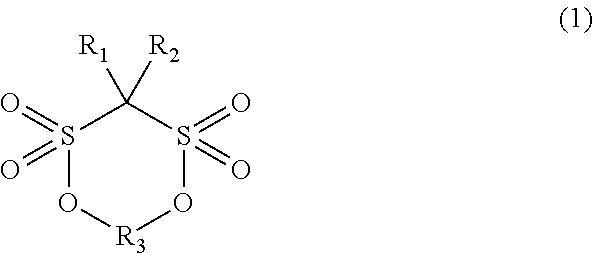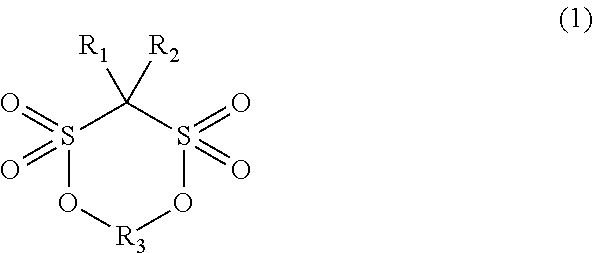Lithium ion secondary battery
a secondary battery and lithium ion technology, applied in the field of lithium ion secondary batteries, can solve the problems of progressing in the discharge capacity and degrading the properties of the secondary battery, and achieve the effect of reducing the capacity and excellent storage characteristics
- Summary
- Abstract
- Description
- Claims
- Application Information
AI Technical Summary
Benefits of technology
Problems solved by technology
Method used
Image
Examples
example 1
Preparation of Lithium Ion Secondary Battery
[0080]The preparation of the battery of the present Example 1 is described. As the positive electrode current collector, a 20 van-thick aluminum foil was used, and as the positive electrode active material, LiMn2O4 was used. As the negative electrode current collector, a 10 μm-thick copper foil was used, on the copper foil, 95% by mass of spherical natural graphite A (average particle size D50=20 μm) was used as the negative electrode active material. The average particle size was determined from the measurement of the volume-based particle size distribution with a particle size / particle size distribution measurement apparatus based on a laser diffraction-scattering method detecting the particle size from laser light scattering. Then, the negative electrode and the positive electrode are laminated on each other through the intermediary of a separator made of polyethylene, and thus, a secondary battery was prepared. In the production of the...
example 2
[0087]A secondary battery was prepared in the same manner as in Example 1 except that 95% by mass of the massive artificial graphite A (average particle size D50=10 μm) was used as the negative electrode active material in place of the spherical natural graphite A (average particle size D50=20 μm). Subsequently, the properties of the battery were examined in the same manner as in Example 1. The results thus obtained are shown in Table 2.
example 3
[0088]A secondary battery was prepared in the same manner as in Example 1 except that 95% by mass of the massive non-graphitizable carbon A (average particle size D50=9 μm) was used as the negative electrode active material in place of the spherical natural graphite A (average particle size D50=20 μm). Subsequently, the properties of the battery were examined in the same manner as in Example 1. The results thus obtained are shown in Table 2.
PUM
| Property | Measurement | Unit |
|---|---|---|
| time | aaaaa | aaaaa |
| energy density | aaaaa | aaaaa |
| charging capacity | aaaaa | aaaaa |
Abstract
Description
Claims
Application Information
 Login to View More
Login to View More - R&D
- Intellectual Property
- Life Sciences
- Materials
- Tech Scout
- Unparalleled Data Quality
- Higher Quality Content
- 60% Fewer Hallucinations
Browse by: Latest US Patents, China's latest patents, Technical Efficacy Thesaurus, Application Domain, Technology Topic, Popular Technical Reports.
© 2025 PatSnap. All rights reserved.Legal|Privacy policy|Modern Slavery Act Transparency Statement|Sitemap|About US| Contact US: help@patsnap.com



